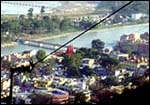


|
|
 |
| HOME | TRAVEL | TRAVELOG | ||

The Greatest Mela on Earth ... the Kumbh at Haridwar Vaihayasi P Daniel. Photographs by Jewella C Miranda.
Haridwar does every 12 years. Like an adolescent, this temple town on the Ganga suddenly develops an angry rash of orange spots. The rash has struck again this year. Actually a tidal wave of orange has flowed into Haridwar. Some 20,000 sadhus -- or holy men -- all traditionally clad in shades of saffron, have swamped the town for an event that is touted to be the largest religious gathering on the planet -- the legendary Kumbh Mela.
Knots of sadhus, swathed in orange, roam the neighbourhoods, playing the tourist, visiting each quaint Haridwar temple and tiny shrine. Holy men pop in and out of the chota das paisa souvenir shops bargain hunting -- maybe for a better trishul or mala. Sanyasins -- the feminine variety -- draped in pale saffron head towards the ghats for a walk. Novice sadhus -- little lads of 10 or 11 wrapped in orange cotton and wood ash -- are out learning how to survive. "This is our festival. It is a sant's mela," explains Shree Mahant Meerapuri, a senior sanyasin from Nahan, Himachal Pradesh. Meerapuri is one of the thousand odd sanyasins who have come for the Kumbh. The Kumbh Mela is the place to be, this season, for India's fascinating legion of saffron-habited monks. They have come off the buses. Off trains. On foot. From all corners of India. And from as far afield as Australia, Germany, Nepal, Switzerland, USA. From ashrams and mandirs. From remote Himalayan caves, forests and lonely mountain locations where many have been in meditation for years together.
To celebrate the anointment of these four holy places, a Kumbh Mela is held every three years at one of these cities, in rotation. The sacred time this year was meticulously ascertained from the movement of the planets and stars and after rounds of painstaking number crunching by astrologers and pandits. A series of auspicious bathing dates were released so that devout Hindus could gather for the 12 Great Baths when it is believed that the waters of the Ganga turn to amrit.
The intense, ferocious-looking Nagas -- the naked sadhus who have given up everything in life including their clothes -- lead the charge into the water, their bodies caked with ash. And in order of hierarchy the acharyas, sants and mata sants follow suit. Despite all the precautions, this giant bathing ceremony has more than its usual quotient of pandemonium. During many months in this quiet town, there has been hectic activity in the sadhu world. Apart from the colourful ceremonies that the sadhus choreograph at the ghats on the bathing days, matters of leadership, politics, needed to be debated over. It's time for plenty of gup-shup, religious discourse, inter-akhara discussions and for serious worship. The sadhus also receive a number of visitors at the tent townships where they live. Locals and outsiders who have come to Haridwar for the Kumbh seek their blessings and advice. And, of course, the sadhus performing penance attract awed and respectful bystanders.
Something of an unruly kid, he is the pride of his sadhu seniors and has his own minder. Crowds gather to watch his antics as he dances about on his bow legs and romps on his swing which is the only support for his calves that have not been flexed for the last 3,300 days. "What do I think of the Kumbh Mela? It is gooood (he practises his English). Even if you spend Rs 100,000,000 you won't get the darshan of so many sadhus in one place except at the Kumbh." Photographs by Jewella C Miranda
|
|
|
Continued
|
|
|
|
|
|
HOME |
NEWS |
BUSINESS |
CRICKET |
MOVIES |
CHAT
INFOTECH | TRAVEL | LIFE/STYLE | FREEDOM | FEEDBACK |
|